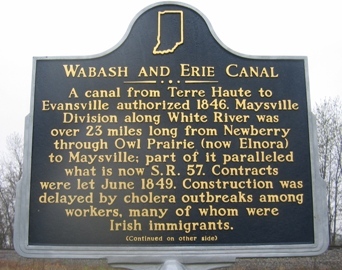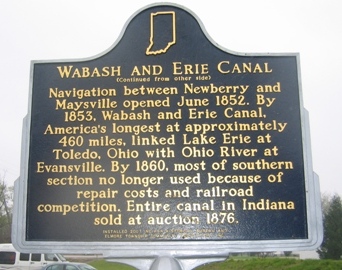Wabash and Erie Canal


Location: State Highway 58 and State Highway 57, Elnora (Daviess County, Indiana)
Installed: 2007 Indiana Historical Bureau and Elmore Township Community Association, Inc.
ID# : 14.2007.1
Text
Side one:
A canal from Terre Haute to Evansville authorized 1846. Maysville Division along White River was over 23 miles long from Newberry through Owl Prairie (now Elnora) to Maysville; part of it paralleled what is now S.R. 57. Contracts were let June 1849. Construction was delayed by cholera outbreaks among workers, many of whom were Irish immigrants.
Side two:
Navigation between Newberry and Maysville opened June 1852. By 1853, Wabash and Erie Canal, America's longest at approximately 460 miles, linked Lake Erie at Toledo, Ohio with Ohio River at Evansville. By 1860, most of southern section no longer used because of repair costs and railroad competition. Entire canal in Indiana sold at auction 1876.
Keywords
Business, Industry, and Labor, Transportation
Annotated Text
Side one:
A canal from Terre Haute to Evansville authorized 1846.(1) Maysville Division along White River was over 23 miles long(2) from Newberry through Owl Prairie (now Elnora) to Maysville; part of it paralleled what is now S.R. 57.(3) Contracts were let June 1849.(4) Construction was delayed by cholera outbreaks among workers, many of whom were Irish immigrants.(5)
Side two:
Navigation between Newberry and Maysville opened June 1852.(6) By 1853, Wabash and Erie Canal, America's longest at approximately 460 miles, linked Lake Erie at Toledo, Ohio with Ohio River at Evansville.(7) By 1860, most of southern section no longer used because of repair costs and railroad competition.(8) Entire canal in Indiana sold at auction 1876.(9)
Notes
(1) Indiana Laws 1846, p. 58. On January 19, 1846 an act was approved "to provide for the payment of the expenses of selecting and classifying the Lands granted by Congress, for the completion of the Wabash and Erie Canal from Terre Haute to Evansville." Ibid (B00455).
On January 27, 1847, an act supplementary to the 1846 act was approved "for the Funded debt of the State of Indiana, and for the completion of the Wabash and Erie Canal from Terre Haute to Evansville." Indiana Laws, 1847, p. 11(B00456).
(2) Wabash and Erie Canal Annual Report, 1849, p. 255 (B00471); "Map of Daviess County, " Maps of Indiana, 1876 (B00464).
(3)Modern researchers have mapped the route of the canal bed. From near Newberry, Greene County, to Plainville, Daviess County, the canal bed parallels what is now State Road 57. The canal bed then continued southwest to Maysville, Daviess County. Carolyn I. Schmidt, ed., Wabash & Erie Canal: Canal Society of Indiana, March 27-29, 1998, Vincennes: The Final Link (Fort Wayne, 1998) (B00441).
Within the canal sources, there are two different spellings for Newberry-Newberry and Newbury. Throughout my research, I have seen two spellings-Newberry and Newbury. I went through each of the Wabash and Erie Canal Board of Trustees Annual Reports. I found that from 1849 the Board, resident, and chief engineers used both spellings interchangeably until 1858. After that, it seems consistently written as Newberry including the last report written in 1874. Spellings are as follows: 1876 Map of Indiana Counties-Newbury (B00464); "Profile of the Wabash and Erie Canal, " (1984)-Newberry; (B00522); Ronald L. Baker, From Needmore to Prosperity: Hoosier Place Names in Folklore and History (Bloomington, 1995), 124-Newberry (B00521); Indiana Atlas and Gazetteer, (1998)-Newberry (B00524); and Indiana Transportation Map for 2005-2006-Newberry (B00526).
Elnora was originally called Owl Prairie when a post office was established there in 1831. Elnora, was laid out on September 25, 1885. The post office name changed officially to Elnora on December 11, 1885. According to the Post Office Card Catalogue #345 and #346, the beginning date of the Elnora post office was December 11, 1885. J. David Baker, The Postal History of Indiana, Vol. 11 (Louisville, 1976), 932 (B00523) and Annual Report of the Trustees of the Wabash and Erie Canal to the General Assembly of the State of Indiana, 1850 (Indianapolis, 1851), p. 146 (B00474). [Hereafter, the Annual Report of the Trustees].
In compliance with the January 28, 1830 law, "An act providing means to construct the portion of the Wabash and Erie Canal within the State of Indiana, " a Board of Trustees was elected. In Section 3 states, " a quarterly report of their contracts and accounts shall be transmitted by them to the auditor of public accounts, and an annual report of all their proceedings, contracts and accounts, to the general assembly, by the second Monday in December." Section 13 required the commissioners to employ an "experienced engineer, of known skill and established character, to act as chief engineer" and for that engineer "to report his progress to the next general assembly, during the first week thereof." The chief engineer was to do his duties, "with such assistants as he may deem necessary." Indiana Laws, 1830, p. 14, 17-18 (B00527).
The annual reports for the years 1844-1874 included
- A report by the resident engineer, who submitted his report to the chief engineer,
- A report by the chief engineer, who submitted his report to the Board of Trustees,
- A report by the Board of Trustees, who submitted their report to the General Assembly.
Many times the dates of the reports were just days apart. Some resident and chief engineer reports were dated the same day. During the construction of the lower section of the Wabash and Erie Canal, the two men shared the same Terre Haute office. The annual reports for the years 1844-1852 have been bound into one volume, Report of the Superintendent of the Wabash and Erie Canal (catalog # I626W112r, Indiana State Library, Indianapolis). There is no title page or publisher listed. Each annual report was published in Indianapolis by the state printer. The annual reports for the years 1853-1874 have been bound into one volume, Annual Report of the Board of Trustees of the Wabash and Erie Canal to the Governor (catalog # I626W112r, Indiana State Library). There is no title page or publisher listed. Each report was published in Indianapolis by the state printer. According to the Indiana State Library Catalogue, the Library has the annual reports from 1829-1874, all under the same catalog number, I626W112r. The 1829 date seems odd because the Board was not created until 1830. Earliest reports, except for those in 1833 and 1835, have not been located.
(4) Wabash and Erie Canal Annual Report, 1849, p. 283-84 (B00466).
(5) Construction halted when cholera hit the entire southern section of the canal in 1849 and again in May, June, and July of 1850; 150 canal workers died during this outbreak. In 1851 and 1852 there were also less severe outbreaks of cholera. Early in 1851 rains and high waters delayed the construction of the Maysville Division until fall. Wabash and Erie Canal Annual Report, 1849, pp. 283-84 (B00466); Wabash and Erie Canal Annual Report, 1850, p. 173 (B00497); George Sutton, "A Report to the State Medical Society, on Asiatic Cholera, as it Prevailed in This State in 1849-50-51-52, " Proceedings of the 2nd Annual Meeting of the Indiana State Medical Society Held in the City of Indianapolis, May 1851 (Indianapolis, 1851), p. 157 (B00478); Wabash and Erie Canal Annual Report, 1851, p. 247 (B00476).
Stultz, Carol, 1850 Davies[s] County Indiana US Federal Census (Danville, [1988]). According to the 1850 Federal Census, many of the canal workers in Elmore Township, Daviess County were from Ireland. (B00525) Also see Schmidt, The Final Link. (B00441)
(6) Wabash and Erie Canal Annual Report, 1852, p. 336 (B00479).
(7) Standard text for all Wabash and Erie Canal markers.
(8) Wabash and Erie Canal Annual Report, 1856, p. 285; (B00480) Wabash and Erie Canal Annual Report, 1858, pp. 293-94 (B00482); Wabash and Erie Canal Annual Report, 1859, p. 299 (B00492); Wabash and Erie Canal Annual Report, 1861, pp. 386-87 (B00501); Ralph D. Gray, "The Canal Era in Indiana" in Transportation and the Early Nation (Indianapolis, 1982), 126-27 (B00509).
According to Ralph D. Gray, during the late 1840s and early 1850s the income from the southern section of the canal was encouraging, and income from the entire canal peaked in 1852. Regarding the canal's impact, Gray explains, "The Wabash and Erie Canal did not pour cash into the pockets of its investors; on the other hand, its developmental impact on the state, in both the northern and southern areas, where renewed lands sales and settlement had been stimulated, can clearly be seen. For their time and place, the two Indiana canals which were completed and in operation for some twenty to forty years-the Whitewater and the Wabash and Erie canals-had a positive impact upon their regions, served to stimulate agricultural and urban growth, and helped develop the towns, millsites, the population, and the trade which the railroads of a later time dominated so completely." Gray, "The Canal Era, " 129 (B00509).
Concerning the decline of the canal, Gray contends, "Income from rents, tolls, and land sales was promising during the late 1840s and early 1850s-the peak year for the entire canal as a whole was 1852-and slowly but steadily, despite repeated outbreaks of cholera and other epidemics among the canal laborers, the waterway inched its way through the southwestern counties of Indiana to the Ohio River at Evansville. It was clear to most observers, however, that already the canal's days were numbered; the southern extension, on which more than $ 2 million was spent in construction, returned less than half that much in tolls and rents during its seven partial years of operation. To the board, the reason for this was clear: it did not lie in the long interruptions to navigation caused by floods and vandalism (there were examples of both); rather it stemmed from inattention if not perversity, of the state legislature in authorizing railroads to parallel virtually every mile of the canal during the 1850s." Ibid. , 126-27 (B00509).
(9) Terre Haute Evening Gazette, February 24, 25, 1876 (B00514).
